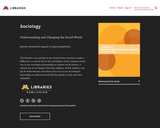
Video lesson covering the concepts of absolute and relative poverty.
- Subject:
- Social Science
- Sociology
- Material Type:
- Lesson
- Provider:
- Khan Academy
- Date Added:
- 11/21/2023

Video lesson covering the concepts of absolute and relative poverty.

Video lesson covering class consciousness and false consciousness.

According to Pierre Bourdieu, cultural capital is the cultural knowledge that serves as the currency that helps us navigate a culture and alters our experiences and the opportunities available to us. This theory focuses on the embodied, objectified and institutionalized states of capital and is significantly important in assisting us in understanding inequality in education and other social structures. Further explanation of cultural capital can be found on page 365 of the Sociology 2e text by OpenStax College.

This report presents data on income, earnings, income inequality, and poverty in the United States based on information collected in the 2018 and earlier Current Population Survey Annual Social and Economic Supplements (CPS ASEC) conducted by the U.S. Census Bureau.

Intercultural Communication examines culture as a variable in interpersonal and collective communication. It explores the opportunities and problems arising from similarities and differences in communication patterns, processes, and codes among various cultural groups. It explores cultural universals, social categorization, stereotyping and discrimination, with a focus on topics including race, ethnicity, social class, religion, gender and sexuality as they relate to communication.

The Introduction to Sociology Course was developed through the Ohio Department of Higher Education OER Innovation Grant. This work was completed and the course was posted in September 2018. The course is part of the Ohio Transfer Module and is also named OSS021. For more information about credit transfer between Ohio colleges and universities, please visit: www.ohiohighered.org/transfer.Team LeadIrene Petten Columbus State Community CollegeContent Contributors Dee Malcuit Clark State Community CollegeKwaku Oboso-Mensah Lorain County Community CollegeAnjel Stough-Hunter Ohio Dominican UniversityLibrarianSherri Saines Ohio UniversityReview TeamEric Jorrey Central Ohio Technical College


OER Text materialExplaining StratificationSociology: Understanding and Changing the Social World Section 8.1 discusses differences in how Karl Marx and Max Weber viewed class societies. Section 8.2 provides a great discussion of theoretical perspectives on class. The section on functionalism includes an overview of Davis and Moore’s work. The conflict theory section includes a nice discussion of Marx and of false-consciousness. Instructors may want to supplement material on Weber. The section on symbolic interactionism includes a discussion of conspicuous consumption. Chapter 8 does not discuss Bourdieu, cultural capital, or social capital. Instructors interested in the social reproduction of class should consider supplemental sources.Theoretical Perspectives on Social Stratification - OpenStaxYou could supplement with Open Stax section 9.4 as it provides a summary of how each major sociological paradigm (functionalism, conflict theory, and symbolic interactionism) understands stratification. This includes a brief discussion of the Davis and Moore thesis. The conflict theory section only discusses Marx and not Weber. This section will be need to be supplemented with other sources.

OER Text materialSocial Class in the United StatesSociology: Understanding and Changing the Social World- Chapter 8 Section 3This section begins by explaining the difference between measuring class objectively or subjectively. A pie chart with 2008 GSS data is used to illustrate subjective measurement of social class. The section continues with a discussion of the American class structure and an overview of the major class divisions. Finally social mobility is discussed. The objectives at the start of the section state that a functionalist and conflict theorist view of the American class structure is presented, however, there is only a slight mention of these perspectives in this chapter. This is not the section to use for a theoretical discussion of class. The concepts of status, status inconsistency and status symbol are not discussed in this textbook. Conspicuous consumption is addressed briefly in section 8.2, but many key terms related to social class are missing.What is Social Stratificiation? Open Stax does provide a definition of status consistency, inconsistency and meritocracy.

OER Text materialSystems of StratificationSociology: Understanding and Changing the Social World, Chapter 8, Section 1This section defines systems of stratification including slavery, estate systems, caste systems and class systems. It also explains the difference between open and closed systems and provides a brief discussion of vertical mobility. The chapter concludes with is a brief comparison of Marx and Weber’s views on class.

Introduction to Sociology 2e adheres to the scope and sequence of a typical, one-semester introductory sociology course. It offers comprehensive coverage of core concepts, foundational scholars, and emerging theories, which are supported by a wealth of engaging learning materials. The textbook presents detailed section reviews with rich questions, discussions that help students apply their knowledge, and features that draw learners into the discipline in meaningful ways. The second edition retains the book’s conceptual organization, aligning to most courses, and has been significantly updated to reflect the latest research and provide examples most relevant to today’s students. In order to help instructors transition to the revised version, the 2e changes are described within the preface.

This is a video lesson teaching the concept of social reproduction, or the phenomenon of social inequality repeating itself across generatons.

The founders of sociology in the United States wanted to make a difference. A central aim of the sociologists of the Chicago school was to use sociological knowledge to achieve social reform. A related aim of sociologists like Jane Addams, W.E.B. DuBois, and Ida B. Wells-Barnett and others since was to use sociological knowledge to understand and alleviate gender, racial, and class inequality.
Steve Barkan’s Sociology: Understanding and Changing the Social World makes sociology relevant for today’s students by balancing traditional coverage with a fresh approach that takes them back to sociology’s American roots in the use of sociological knowledge for social reform.
Print on demand edition available here: https://www.uncpress.org/book/9781469659282/sociology/

Infographics on the distribution of wealth in America, highlighting both the inequality and the difference between our perception of inequality and the actual numbers. The reality is often not what we think it is.